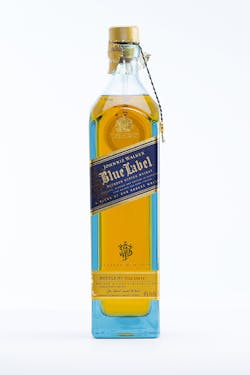A guy walks into a liquor store, heads to the whiskey aisle and stops for a second to contemplate which of the many brands on the shelf he will buy. Suddenly, his smartphone pings him with a message: “Johnnie Walker Blue Label has layers of big flavor and a deep richness that has a smoky smooth finish.”
He nods, puts his phone back in his pocket, and grabs a Blue Label bottle. At home, as he uncaps the beverage, his smartphone alerts him of another new message. “Start by serving the Blue Label neat in a tumbler, nosing the whiskey carefully.”
He slowly pours his first glass, as instructed, and then reads the next message on his phone. “Take a sip of iced water before your first sip of whiskey to make sure the palate is cooled and refreshed.” Ah, good advice, he thinks as he heads to the kitchen.
These mysterious messages may seem a bit eerie as they pop up at just the right moment, giving the impression that this guy is under surveillance. But, he’s not being watched, he’s being sensed—by a smart bottle.
Welcome to the world of omni-channel marketing where manufacturers can engage directly with a consumer regardless of where they are (online or in the physical store) or what communication method they are using (printed catalog, website, mobile app, or social media). In this scenario, Diageo plc, a global beverage provider with a large collection of alcohol brands-- including Crown Royal, Captain Morgan, Ketel One, and Johnnie Walker-- is taking multi-channel marketing to the next level with the addition of the Blue Label smart bottle.
Together with Thin Film Electronics ASA, a supplier of printed electronics and smart systems, the company is testing the connected “smart bottle” designed to enhance the customer experience through real-time interaction. Thinfilm’s new OpenSense technology includes near field communication (NFC) which enables smartphones and tablets to communicate with other close-range devices containing a NFC tag.
The OpenSense tag covers the seal of the bottle’s cap and carries digital information that can be accessed by NFC smartphones. OpenSense is designed with dynamic detection of a product’s “sealed” and “open” states that supports a variety of real-time marketing, product authentication, and security applications. The manufacturer, for example, can push targeted messages, such as promotional offers, cocktail recipes, and exclusive content, to the consumer at just the right time.
Thinfilm’s printed electronics, which support memory, sensing, and logic, is a low-cost and highly scalable alternative to traditional silicon systems. (Technology Watch: Printed Electronics.) Couple the technology with NFC and the ability to sense different product states, and there are new opportunities for food and beverage, pharmaceutical, and healthcare industries to track product location, temperature, movement, moisture, and more. It can even help control inventory and identify if a product has been tampered with.
Unlike conventional static QR codes that are often difficult to read, easy to copy, and do not support sensor integration, OpenSense tags can ensure product authenticity as they are permanently encoded at the point of manufacture and cannot be copied or electrically modified, Thinfilm officials say.
In addition, while RFID tags are the common way to track perishable products during distribution, they are attached to a shipping crate. Smart labels with printed electronics can be attached to individual items. This opens the door to help manufacturers easily—and affordably—adopt wireless sensing capabilities throughout the supply chain as well as build out an Internet of Things (IoT) network that includes smart bottles.
“The Internet of Things is huge for us,” says Jennifer Ernst, Thinfilm’s Chief Strategy Officer. In the Blue Label set up a simple sensor tells the NFC device if the seal is broken. “But we are also beginning to introduce temperature sensors for use as industrial process monitors.”
The affordability of printed electronics in high volume quantities is what will drive adoption in the future. “For a few dimes you can add intelligence to products,” Ernst says.
The high-quality consumer experience, however, is what will enable manufacturers to innovate outside of the plant floor.
Diageo will unveil its smart bottle prototype this week at the Mobile World Congress in Barcelona, Spain. “Our collaboration with Thinfilm allows us to explore all the amazing new possibilities enabled by smart bottles for consumers, retailers, and our own business,” says Helen Michels, Diageo’s Global Innovation Director. “Mobile technology is changing the way we live, and as a consumer brands company, we want to embrace its power to deliver amazing new consumer experiences in the future.”
About the Author
Stephanie Neil
Editor-in-Chief, OEM Magazine

Leaders relevant to this article:
